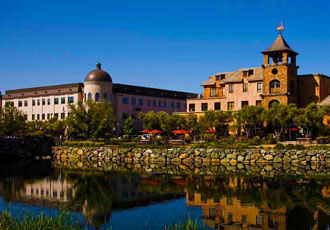El Dorado Hills
 El Dorado Hills lies about 18.6 miles from the 1848 gold find site in Coloma, the impetus for the California Gold Rush. Gold was washed down the South Fork of the American River, into areas now in El Dorado Hills and Folsom, but farming and ranching supplanted the Gold Rush. Portions of two Pony Express routes in this area from 1860-1861 remain as modern El Dorado Hills roads.[citation needed] El Dorado Hills includes the longest surviving section of the Lincoln Highway, the first U.S. transcontinental highway.[citation needed] This section, part of the Pioneer Branch, passes through historic Clarksville and is the predecessor of the modern US 50 route. (?) tely planned from its inception as a group of residential “villages”. Other land uses in the master plan included a business park, 18-hole golf course, community parks, schools, a community shopping center, and small commercial centers in each village. The master plan[citation needed] emphasized open space between villages and opportunity for outdoor recreation.
El Dorado Hills lies about 18.6 miles from the 1848 gold find site in Coloma, the impetus for the California Gold Rush. Gold was washed down the South Fork of the American River, into areas now in El Dorado Hills and Folsom, but farming and ranching supplanted the Gold Rush. Portions of two Pony Express routes in this area from 1860-1861 remain as modern El Dorado Hills roads.[citation needed] El Dorado Hills includes the longest surviving section of the Lincoln Highway, the first U.S. transcontinental highway.[citation needed] This section, part of the Pioneer Branch, passes through historic Clarksville and is the predecessor of the modern US 50 route. (?) tely planned from its inception as a group of residential “villages”. Other land uses in the master plan included a business park, 18-hole golf course, community parks, schools, a community shopping center, and small commercial centers in each village. The master plan[citation needed] emphasized open space between villages and opportunity for outdoor recreation.
Between the late ’60s and mid-1990s growth occurred at a moderate pace as new families relocated from Sacramento, Southern California and the Bay Area. This growth consisted primarily of residential housing, as retail developments were limited to two shopping centers on the corners Green Valley & Francisco and El Dorado Hills Blvd. & Hwy. 50. Each neighborhood created during this time period was given a name and referred to as a “village” by local inhabitants. The original villages of El Dorado Hills include Park, Saint Andrews, Crown, Governors. In the 1980s and 1990s the major part of Lake Hills Estates north of Green Valley Road, was reorganized into Lake Forest Village,[8] containing the neighborhoods of Waterford, The Summit,[9] Green Valley Hills, Winterhaven, Marina Woods and Windsor Point. Additional villages that have developed subsequently include Fairchild, Sterlingshire, Highland Hills, Highland View, Bridlewood, Hills of El Dorado, Woodridge, Laural Oaks and the master-planned community of Serrano.
The 1990 census, reported that El Dorado Hills had a population of 6,395. Growth slowed during the early part of the ’90s due to economic recession throughout California, but resumed at a staggering pace by the mid-1990s. Businesses, particularly those interested in escaping the high costs of Silicon Valley began to set up operations in the El Dorado Hills Business Park south of Highway 50. In 1995, the Parker Development Company acquired 3,500 acres (14 km2) along the eastern boundary of El Dorado Hills to create Serrano, one of the largest master planned communities in Northern California. Serrano was the site of an innovative case of recycled water irrigation on a large scale.
Around 2000, its population growth and commercial development greatly accelerated. Development began in its Town Center Zone to form a true downtown business area, and its Business Park experienced increasing rates of construction and occupancy.
The new El Dorado Hills Town Center is located just south of Hwy 50. The all-new mixed-use project, a development of The Mansour Company, has successfully pulled together a great mix of uses – local and national retailers, cafés, restaurants and bars, movie theater, hotel, gourmet market, fitness club, day spa, luxury car dealership, professional and medical offices, public amphitheatre, dramatic fountains and waterways, and broad public plazas. Occupying 100 acres of land and, at completion, one million square feet of buildings, it is the center of town and of the region – a place where the community can gather to shop, dine, work, go to the movies, enjoy a concert, and relax on public plazas.
Many families continue to relocate to El Dorado Hills from Sacramento, Southern California and primarily the Bay Area. The housing prices for El Dorado Hills typically range from the low $300,000’s to $4 million range. There are exclusive neighborhoods that offer high end luxury homes such as Serrano Golf and Country Club, The Summit, Watermark, Marina Hills and Highland Hills.
Population Data
| City Population | 42,108 |
| Urban Area Population | 1.393 Million |
| Metro Area Population | 2.176 Million |
Demographics
| Race | White 83.2% | Asian 8.5% |
| Hispanic Origin | 7.5% |
| U.S. Citizen | 97% |
Education
| College Degree or Higher | 61.3% |
| High School Diploma | 12.5% |
| Less Than High School | 2.8% |
Income Data
| Median Household Income | $117,599 |
| Per Capita Income | $45,567 |
| Below Poverty Line | 3.1% |
Economic Data
| Median Home Price | $239,500 |
| Unemployment Rate | 7.4% |
| Sales Tax Rate | 7.5% |
Boundary Maps

